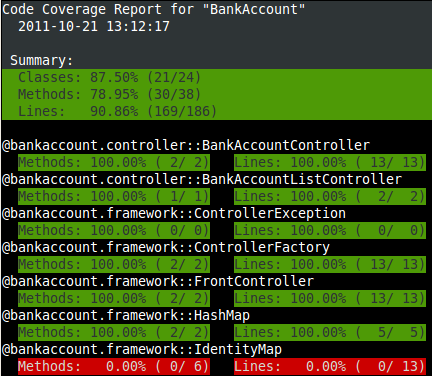PHPUnit は、いくつかの形式のログファイルを作成することができます。
PHPUnit が作成するテスト結果の XML のログファイルは、
Apache Ant の JUnit タスク
が使用しているものを参考にしています。
以下の例は、ArrayTest のテストが生成した
XML ログファイルです。
<?xml version="1.0" encoding="UTF-8"?>
<testsuites>
<testsuite name="ArrayTest"
file="/home/sb/ArrayTest.php"
tests="2"
assertions="2"
failures="0"
errors="0"
time="0.016030">
<testcase name="testNewArrayIsEmpty"
class="ArrayTest"
file="/home/sb/ArrayTest.php"
line="6"
assertions="1"
time="0.008044"/>
<testcase name="testArrayContainsAnElement"
class="ArrayTest"
file="/home/sb/ArrayTest.php"
line="15"
assertions="1"
time="0.007986"/>
</testsuite>
</testsuites>
次の XML ログファイルは、テストクラス
FailureErrorTest にある 2 つのテスト
testFailure および testError
が出力したものです。失敗やエラーがどのように表示されるのかを確認しましょう。
<?xml version="1.0" encoding="UTF-8"?>
<testsuites>
<testsuite name="FailureErrorTest"
file="/home/sb/FailureErrorTest.php"
tests="2"
assertions="1"
failures="1"
errors="1"
time="0.019744">
<testcase name="testFailure"
class="FailureErrorTest"
file="/home/sb/FailureErrorTest.php"
line="6"
assertions="1"
time="0.011456">
<failure type="PHPUnit_Framework_ExpectationFailedException">
testFailure(FailureErrorTest)
Failed asserting that <integer:2> matches expected value <integer:1>.
/home/sb/FailureErrorTest.php:8
</failure>
</testcase>
<testcase name="testError"
class="FailureErrorTest"
file="/home/sb/FailureErrorTest.php"
line="11"
assertions="0"
time="0.008288">
<error type="Exception">testError(FailureErrorTest)
Exception:
/home/sb/FailureErrorTest.php:13
</error>
</testcase>
</testsuite>
</testsuites>
Test Anything Protocol (TAP)
は、Perl のモジュールをテストする際に使用する、
シンプルなテキストベースのインターフェイスです。
以下の例は、ArrayTest のテストが生成した
TAP ログファイルです。
TAP version 13 ok 1 - testNewArrayIsEmpty(ArrayTest) ok 2 - testArrayContainsAnElement(ArrayTest) 1..2
次の TAP ログファイルは、テストクラス
FailureErrorTest にあるメソッド
testFailure および testError
が出力したものです。失敗やエラーがどのように表示されるのかを確認しましょう。
TAP version 13
not ok 1 - Failure: testFailure(FailureErrorTest)
---
message: 'Failed asserting that <integer:2> matches expected value <integer:1>.'
severity: fail
data:
got: 2
expected: 1
...
not ok 2 - Error: testError(FailureErrorTest)
1..2
JavaScript Object Notation (JSON)
は、軽量なデータ交換用フォーマットです。次の例は、
ArrayTest のテストが作成した JSON メッセージです。
{"event":"suiteStart","suite":"ArrayTest","tests":2}
{"event":"test","suite":"ArrayTest",
"test":"testNewArrayIsEmpty(ArrayTest)","status":"pass",
"time":0.000460147858,"trace":[],"message":""}
{"event":"test","suite":"ArrayTest",
"test":"testArrayContainsAnElement(ArrayTest)","status":"pass",
"time":0.000422954559,"trace":[],"message":""}
次の JSON メッセージは、
FailureErrorTest にある 2 つのテスト
testFailure および testError
が出力したものです。失敗やエラーがどのように表示されるのかを確認しましょう。
{"event":"suiteStart","suite":"FailureErrorTest","tests":2}
{"event":"test","suite":"FailureErrorTest",
"test":"testFailure(FailureErrorTest)","status":"fail",
"time":0.0082459449768066,"trace":[],
"message":"Failed asserting that <integer:2> is equal to <integer:1>."}
{"event":"test","suite":"FailureErrorTest",
"test":"testError(FailureErrorTest)","status":"error",
"time":0.0083.90152893066,"trace":[],"message":""}
PHPUnit がコードカバレッジ情報のログ出力の際に使用している XML のフォーマットは、
Clover
のものを参考にしています。
以下の例は、BankAccountTest のテストが生成した
XML ログファイルです。
<?xml version="1.0" encoding="UTF-8"?>
<coverage generated="1184835473" phpunit="3.6.0">
<project name="BankAccountTest" timestamp="1184835473">
<file name="/home/sb/BankAccount.php">
<class name="BankAccountException">
<metrics methods="0" coveredmethods="0" statements="0"
coveredstatements="0" elements="0" coveredelements="0"/>
</class>
<class name="BankAccount">
<metrics methods="4" coveredmethods="4" statements="13"
coveredstatements="5" elements="17" coveredelements="9"/>
</class>
<line num="77" type="method" count="3"/>
<line num="79" type="stmt" count="3"/>
<line num="89" type="method" count="2"/>
<line num="91" type="stmt" count="2"/>
<line num="92" type="stmt" count="0"/>
<line num="93" type="stmt" count="0"/>
<line num="94" type="stmt" count="2"/>
<line num="96" type="stmt" count="0"/>
<line num="105" type="method" count="1"/>
<line num="107" type="stmt" count="1"/>
<line num="109" type="stmt" count="0"/>
<line num="119" type="method" count="1"/>
<line num="121" type="stmt" count="1"/>
<line num="123" type="stmt" count="0"/>
<metrics loc="126" ncloc="37" classes="2" methods="4" coveredmethods="4"
statements="13" coveredstatements="5" elements="17"
coveredelements="9"/>
</file>
<metrics files="1" loc="126" ncloc="37" classes="2" methods="4"
coveredmethods="4" statements="13" coveredstatements="5"
elements="17" coveredelements="9"/>
</project>
</coverage>
人間が読める形式のコードカバレッジ情報を、コマンドラインあるいはテキストファイルに出力します。
この出力フォーマットの狙いは、ちょっとしたクラス群のカバレッジの概要を手軽に把握することです。
大規模なプロジェクトでは、このフォーマットを使えばプロジェクト全体のカバレッジを大まかに把握しやすくなるでしょう。
--filter と組み合わせて使うこともできます。
コマンドラインから使う場合は php://stdout に書き込みます。
この出力は --colors の設定を反映したものになります。
コマンドラインから使った場合は、デフォルトの出力先は標準出力となります。
デフォルトでは、テストで少なくとも一行はカバーしているファイルしか表示しません。
この設定は、xml の showUncoveredFiles オプションでしか変更できません。
「ログ出力」 を参照ください。
デフォルトでは、すべてのファイルとそのカバレッジ情報が、詳細形式で表示されます。
この設定は、xml のオプション showOnlySummary で変更できます。
